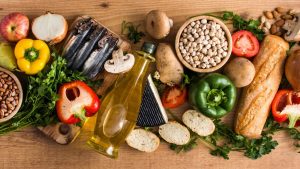By Heide Kennedy, Arizona Farm Bureau Communications Intern
Recently, there has been a lot of hype surrounding the Mediterranean diet and the health benefits that come along with eating this way. And, if you study what makes up the Mediterranean diet, you’ll discover that even in Arizona, we grow or raise quite a bit of what the diet calls for. 
According to registered dietician-nutritionist Janet Helm, those who follow the Mediterranean diet are more likely to be at a healthy weight and have a lesser risk of developing heart disease, diabetes, or cancer. But following this diet can often be on the pricier side. So, here are some dieticians’ tips for following the Mediterranean diet while staying on a budget as well!
Center meals around whole grains.
Whole grains are an integral part of the Mediterranean diet. Think rice, quinoa, wheat berries, farro, bulgur, and others. Whole grains are very shelf stable and are often sold in bulk, which is much cheaper than buying prepackaged whole grain products like bread, pasta, or crackers.
Use beans.
Beans, whether they be canned, fresh, or dried, are a great source of protein. Plus, the canned and dried varieties are very shelf stable so there is no need to worry about spoilage. Thanks to their versatility, use them to add protein to different dishes.
Use canned fish.
Fish is also an important ingredient featured in many Mediterranean diet recipes. But, as we all know, fish can be quite challenging to cook or find your favorite variety, especially for those of us who live in Arizona. So, try using canned fish. And, our grocery markets normally have a wonderful selection of fresh fish. While there is nothing better than fresh fish, certain recipes would come out almost the same as canned fish, and your wallet will thank you.
Cut your greens and make your dressings yourself.
While the convenience of pre-made dressing or pre-cut veggies is always nice, especially on a time crunch, it is not the most economical. Instead, buy whole veggies and cut them yourself. Also, make your own dressings using oils, vinegar, seasonings, and other ingredients you already have around the house!
Use frozen vegetables.
Frozen vegetables are a convenient, cheaper way to add veggies to your meals. Not only do they last a long time, but they are often fresher since they are frozen quickly after harvesting. And, they contain the same nutrition as their fresh counterparts!
While buying high-quality, nutritious foods can be expensive, it doesn’t always have to be. Follow some of these tips and look for other ways to save a little on groceries when you can. A little always add up!
For more health-related articles, check out the Fill Your Plate blog!

